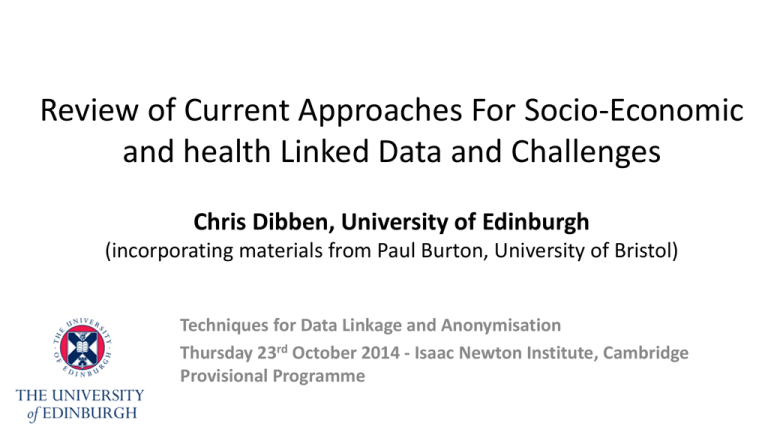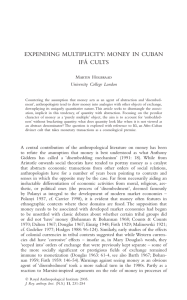
Review of Current Approaches For Socio-Economic
and health Linked Data and Challenges
Chris Dibben, University of Edinburgh
(incorporating materials from Paul Burton, University of Bristol)
Techniques for Data Linkage and Anonymisation
Thursday 23rd October 2014 - Isaac Newton Institute, Cambridge
Provisional Programme
Overview
• Why - are the social and medical sciences
linking/ sharing data?
• How – is this being done?
• What – are the challenges?
Raises important issues
• Legal
• Ethical
• Public confidence - public engagement
• Privacy maximisation
Graphical view of pooled data (a), horizontally partitioned
(b) and vertically partitioned data (c).
Gaye A et al. Int. J. Epidemiol. 2014;ije.dyu188
© The Author 2014; all rights reserved. Published by Oxford University Press on behalf of the
International Epidemiological Association
Data linking/ sharing – why
bother?
• Statistical power
• Enhanced exposure heterogeneity
• Enhanced inferential robustness from proof of
scientific consistency
• Cost sharing across funders and nations to
control the financial burden of generating data
and samples
5
Natural policy experiments
Source BBC: http://www.bbc.co.uk/news/uk-12928485
Small groups in the population
Source: Scottish Health and
Ethnicity Linkage Study
(SHELS), R. Bhopal et al.
Edinburgh University
Looking across the lifecourse – creating
new cohorts
Linking historical data – The Mental
Survey Test
Age
Year
0
11
34
55
1947
1970
1991
65
2001
Mortality
Hospitalisation
Birth
1936
Occupation (estimated)
Mental
ability
Early life
environment
School
Achievement
(time estimated)
Detailed
household/
individual
information
75
2011
History of very important contributions
–Dutch Famine Birth Cohort
Study – epigenetics, thrifty
phenotype
–Överkalix study –
epigenetics, sex differences
Large scale family
reconstruction studies and
Pedigrees
Case study: Iceland
• Link to genetic studies
• deCODE
–Phasing – associating a gene with a chromosome
-microarray platforms
–Genetic imputation
• Knowing population structure for GWAS
Kong et al. Detection of sharing by descent, long-range phasing and haplotype
imputation Nature Genetics 40, 1068 - 1075 (2008)
Gottfredsson, Magnús, et al. "Lessons from the past: familial aggregation
analysis of fatal pandemic influenza (Spanish flu) in Iceland in
1918."Proceedings of the National Academy of Sciences 105.4 (2008): 13031308.
Methodological issues
–Quality of linkages
–Complexity of queries
–Large scale processing of textual data
–Privacy
Quality of linkages
• Probabilistic matching :
–Uncertainty – what/ who is missing
–Missingness process is complex- difficult to
model
• On the whole research has ignored the
information on missingness held within the data
processing system
Machine
learning –
natural language
processing
Congestion of the kidneys accompanied with dropsy
post-scarletina
congestion-98 kidneys-98 accompanied-106 with-106
dropsy-106 post-10 scarletina-106
Maximising Privacy
• Legal, ethics and public confidence - obligation to
maximise privacy
• Structural and methodology
• Advances – but developing area
Graphical view of pooled data (a), horizontally partitioned
(b) and vertically partitioned data (c).
Gaye A et al. Int. J. Epidemiol. 2014;ije.dyu188
© The Author 2014; all rights reserved. Published by Oxford University Press on behalf of the
International Epidemiological Association
Multi-study analysis in practice: two common
approaches
• Study level meta-analysis
– Simple to use and understand
– It works
– Avoids key governance restrictions
– But can be very inflexible and slow
• Data warehousing
– Simple to use and understand
– It works
– Funders, regulators, RECs feel ‘comfortable’
– All the benefits of federated analysis are disadvantages
– Expensive, particularly if it is to be a ‘secure data enclave’
DataSHIELD: a novel solution
• Take analysis to data … not
data to analysis
• One step analyses: simply
combine non-disclosive
output from all sources
• Iterative analyses: parallel
processes linked together
by entirely non-identifying
summary statistics – e.g.
for glm = score vectors and
information matrices
• Can be used as equivalent
to full individual level
analysis or to study level
meta-analysis
How is it
implemented?
SUMMARY STATISTICS
SVHealthy
487.2951, 149]
5: [36, 487.2951, Obese
Project
BioSHARE-eu
IM5:
500
70.56657
70.56657
297
70.56657
7646.29164
7646.29164
65.39412
70.56657
7646.29164
7646.29164
65.39412
297
65.39412
65.39412
382
Data computer
Individual level data never
transmitted or seen by the
statistician in charge, or by
anybody outside the original
centre in which they are stored.
Opal
Finrisk
R
Data computer
Opal
Prevend
Web services
Web services BioSHaRE Web services
web site
R
Web services
R
Analysis
Computer
Data computer
Opal
1958BC
R
Trusted Third Party
Privacy preserving data linkage
Jim Smith, 5 Apple street, Edinburgh
vvsjwuoskJHOWmoek?:{]]**jedni;wsng[wlll
vvsjwuoskJHOWmoek?:{]]**jedni;wsng[wlll
Jim Smith, 5 Apple street, Edinburgh
Synthetic data
Source: Electronic Arts
Novok, Rabb and Dibben – developed a
package for use with the UK ‘Longitudinal
Studies’
synthpo
p
http://cran.r-project.org/package=synthpop
Conclusion
• Great potential for efficient cost effective
research
• Key challenges being addressed but a
developing area
• Public confidence







